Table of contents
- Portrait of Mitch Arai Company patriarch and enthusiastic motorcyclist
- From hats to hardhat and motorcycle helmets
- Pay particular attention to the maximum penetration resistance
- Young design student created the Arai logo
- Out and about in Japan: Always smile nicely
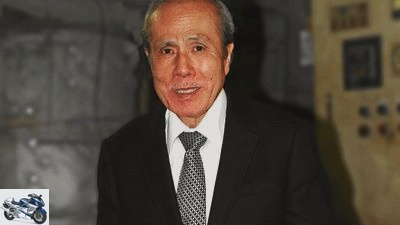
Lohse, factory
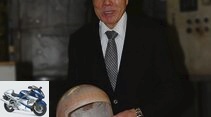

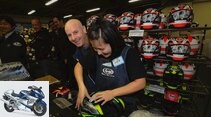

14th pictures
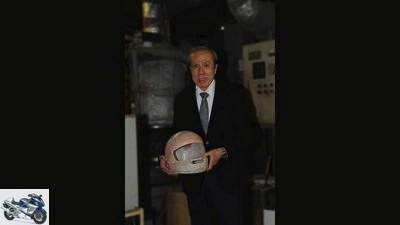
Lohse
1/14
It takes 75 days for a new Arai helmet to end up in the box from the gluing of the first glass fibers to the insertion of the visor. And Mitch Arai, son of the hatter Hirotake, is 75 years old.

Lohse
2/14
After 75 working days, the finished helmet goes into the cloth bag. 300 people are employed at Arai in Japan, 300,000 helmets are produced annually.
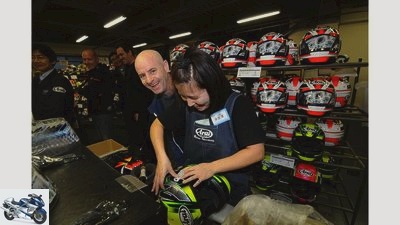
Lohse
3/14
Top testers Schwers and service guru Lohse are even allowed to actively intervene in production.
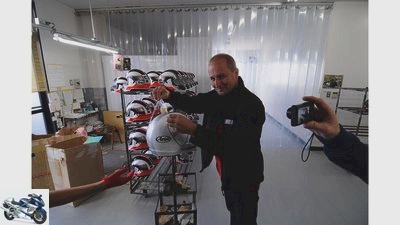
Lohse
4/14
A visit to the factory is not only interesting, but also informative.
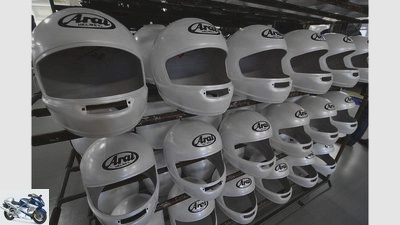
Lohse
5/14
It takes a total of 75 days to manufacture a helmet.

Lohse
6/14
Before the clear lacquer is applied, the decor is applied in filigree manual work.
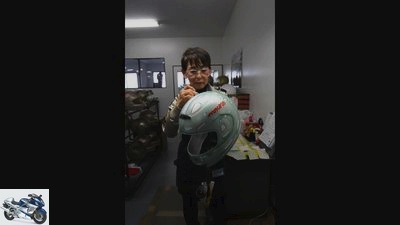
Lohse
7/14
The helmet shells are then prepared for sawing out air inlets and accommodating add-on parts.
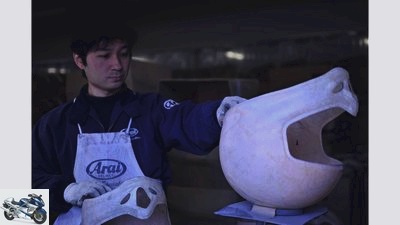
Lohse
8/14
This is what an unpainted and unpolished helmet looks like.

Lohse
9/14
The combination of painting and polishing should ensure a perfect surface finish and not drive the weight up unnecessarily.
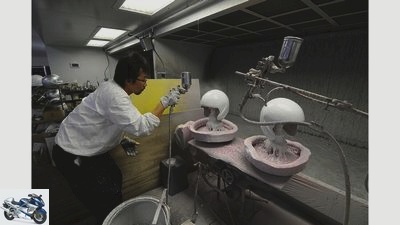
Lohse
10/14
With the shell, it goes on in umpteen individual steps. Here the helmets are being painted.
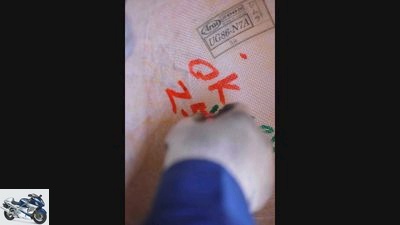
Arai
11/14
Letter and seal: every work step is documented in the helmet shell.

Arai
12/14
Modern: high-strength synthetic fibers should make the shell extremely robust.
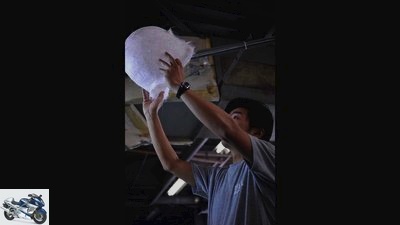
Arai
13/14
Tradition: Arai helmets have been made from fiberglass for decades.
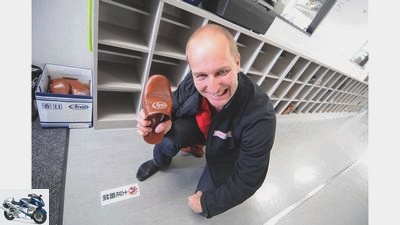
Lohse
14/14
In the factory, too, the motto is: Take your shoes off and put them in the panties.
Sports & scene
Portrait of Mitch Arai
Portrait of Mitch Arai
Company patriarch and enthusiastic motorcyclist
Mitch Arai, son of the hatter Hirotake, is 75 years old. Since 1986 he has been running the family business in Ohmiya, Japan, in the second generation. A portrait of the head of the Japanese motorcycle helmet manufacturer.
Jorg Lohse
06/18/2014
Does that sound familiar to you? One of your beloved US thrillers is just starting on television, and the leading actor, who is already a little gray, enters the scene. The first words fall, he speaks with this well-known dubbing voice: sonorous, bassy, smoky. A thoroughly sympathetic voice that not only sounds absolutely familiar, but at the same time gives you absolute trust. When the calm comes in, but there is also plenty of tension. Are you attuned enough?
Buy complete article

Portrait of Mitch Arai
Company patriarch and enthusiastic motorcyclist
4 pages) as PDF
€ 2.00
Buy now
Then sit with us in diffuse light in an unadorned room, on a cheap plastic chair, at a worn table in Ohmiya / Japan and listen to Mitch Arai talk about how he tells the story of his life. Actually, so begins Mitch, whose real name is Michio and was born on July 22nd, 1938, the story of Arai is more than 100 years old.
From hats to hardhat and motorcycle helmets
It begins in the aforementioned Ohmiya, an industrial city near Tokyo that is now part of the metropolis of Saitama. At the turn of the century, his grandfather Yuichiroh’s hats were particularly popular there in diplomatic circles and with local political figures. Anyone who had seen it on the social floor put an Arai-san hat on their head. One year before Mitch was born, his father Hirotake was supposed to set the course for the future of Grandpa’s family business.
At the age of 31 he founded a hat factory which, after the Second World War, specialized in the manufacture of protective helmets for construction workers and miners. But Mitch’s father wasn’t just an entrepreneur. He was also a passionate motorcyclist. Real, i.e. effective, head protection did not yet exist in the post-war years, which is why Hirotake adapted one of its construction helmets for its own use. Word of this quickly got around in the scene, and Hirotake began building motorcycle helmets for Japanese racing drivers in the early 1950s.
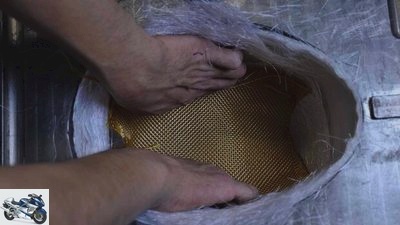
Arai
High-strength synthetic fibers should make the shell extremely robust.
Time and again, his son tells us today, the question naturally arises of who actually developed this modern version of a motorcycle helmet first. Because at the same time, the first Bell helmets were made in California. To find the right answer, Mitch laughs, you have to hire a few more historians. In any case, his father’s business was picking up speed in the direction of two-wheelers – which was also due to his contact with Soichiro Honda, who was looking for suitable suppliers for the development of his legendary Super Cub. It was the exciting founding years of the Japanese motorcycle industry in which the business networks first had to be established.
Even though six decades have passed since that time and, of course, a lot of technical developments, modern materials and, of course, medical knowledge have flowed into the construction of motorcycle helmets – two essential building blocks from the late 1950s have not changed at Arai to this day: the basic construction of the helmet shell made of fiberglass, including a shock-absorbing core made of EPS, better known under the brand name Styrofoam. In order to check the effectiveness of his ideas and prototypes, Hirotake had to develop its own test methods at the time – the really relevant helmet standards around the world would not develop until years later.
Pay particular attention to the maximum penetration resistance
Like his father, young Mitch was an avid motorcyclist who was particularly drawn to the racetrack. But at some point he began to recognize himself: “There are too many who drive faster than me. But I can build better helmets for that. ”After a few years in the USA (where his Japanese first name was eventually“ transferred ”to English), Mitch entered the family business in 1962 and concentrated on expanding the lucrative USA -Business. In the meantime, the first helmet standards had been established, and as early as 1963 Arai was the first Japanese manufacturer to pass the American “Snell” test, in which special attention was paid to the maximum penetration resistance of protective helmets. This philosophy also shapes the design of the Arai helmets to this day.
But that alone should not lead to decisive success in the land of unlimited possibilities. The manageable model range, which until then consisted of a few jet and full-face helmets (since 1967), only bore the initials of their builder Hirotake Arai on their foreheads. But the discreetly attached HA was not really suitable to make the Japanese goods palatable to the American consumer. Together with the then USA importer George S. Nicholson, Mitch pored over a solution during a visit to New York in 1970.
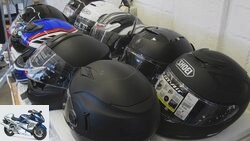
Helmets
8 full-face helmets with sun visors in the test
Motorcycle helmets from 150 to over 600 euros
read more
Buy helmets at markt.motorradonline.de
Young design student created the Arai logo
Both agreed that in the history of the brand it could really only be the family name that should adorn all helmets in the future. Together they sketched, assessed and then discarded. Coincidentally, a young design student was employed as a temporary worker in the New York office that day. The two men gave the 19-year-old their designs and asked them to use them to create a logo for the helmet brand. The next morning, the simple logo, known to this day, was on the desk – the name Arai in cursive, framed by an oval. Mitch was delighted and asked the boy what he wanted for his work. “Just buy me dinner and we’ll be even,” said the still unknown boy. “But then a really big one,” Mitch replied, handing him $ 90 – all the bills he found in his pockets.
But how do you sell motorcycle helmets when you don’t have to wear them? Mitch Arai, like Bell founder Roy Richter, relies on the argument that racing provides: maximum protection in the event of an accident! In the 1970s, the US competitor was still in power on the slopes, but increasingly top drivers also donned Arai helmets. Hirotake experienced Arai’s first world title with Freddy Spencer in 1983, before he died in 1986 and Mitch continued to run Arai Helmet Limited. And just like his father once did, the 75-year-old company patriarch, still an enthusiastic motorcyclist (BMW R 1200 GS), is not thinking of quitting today, although his son Akihito is already actively involved in the company management. This also seems to have a tradition at Arai.
Out and about in Japan: Always smile nicely
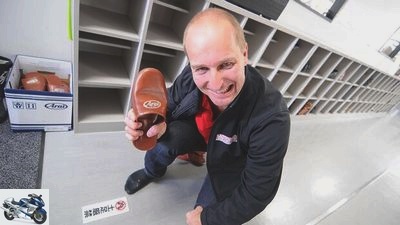
Lohse
In the factory, too, the motto is: Take your shoes off and put them in the panties.
Imagine the opposite case: your own workplace, your usual colleagues – and suddenly a group of exotic-looking people is standing in front of you. Look closely at your fingers, suddenly pull out the camera and talk to each other in an absolutely incomprehensible language. It doesn’t have to be any different for the Japanese when a group from distant Europe suddenly turns up for a factory visit and looks eagerly behind the scenes.
But if you take a few things into account, the ice is broken quickly on both sides. First and foremost, of course, this includes respect and the natural acceptance of cultural peculiarities, such as the greeting ritual without handshakes, but always with a smiling bow.
Related articles
-
Portrait of a motorcycle enthusiast
Detlev Louis motorcycles Portrait of a motorcycle enthusiast Portrait of a motorcycle enthusiast The person behind Detlev Louis Dozens of shops bear his…
-
Givi portrait for the 35th company anniversary
Givi 12th pictures Givi 1/12 The luggage and luggage rack manufacturer Givi celebrated its 35th anniversary in 2013. Lohse 2/12 With all computer…
-
Gori counselor technology & future Portrait: Lino Dainese Interview: Lino Dainese “I want to measure the adrenaline” Who invented it? No, for once not…
-
Shoei Japan 10 pictures Shoei Japan 1/10 This is how a Shoei helmet is made. Shoei Japan 2/10 All overhangs that have arisen during production are…
-
MotoGP – Dorna boss Carmelo Ezpeleta in portrait
2snap Sports & scene Motorsport MotoGP – Dorna boss Carmelo Ezpeleta in portrait MotoGP – Dorna boss Carmelo Ezpeleta in portrait The show master Excited…
-
Portrait: two-wheeler dealer Fritz Roth
Winni washer Sports & scene Portrait: two-wheeler dealer Fritz Roth scene Portrait of Fritz Roth Content of Fritz Roth has dedicated himself to the…
-
Holger Aue Motomania comic artist portrait
archive Sports & scene Holger Aue Motomania comic artist portrait Portrait of comic artist Holger Aue The Motomania man His page is far back in MOTORRAD,…
-
Portrait of HKS high-performance Ketten-Schmiere Czech
Dorothee Czech 7th pictures Czech family 1/7 Picture gallery: motorcycle improver H.G. Czech. Czech family 2/7 Czech was successful in off-road sports in…
-
Sdun 25th pictures Siemer. 1/25 In focus: Fritz W. Egli. Siemer. 2/25 In focus: Fritz W. Egli. Siemer. 3/25 In focus: Fritz W. Egli. Siemer. 4/25 Thickly…
-
Portrait of Claudio Castiglioni
archive Sports & scene Portrait of Claudio Castiglioni Claudio Castiglioni The impresario and the Italian motorcycle history Content of For more than…